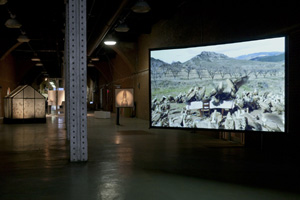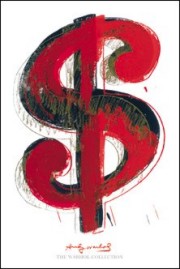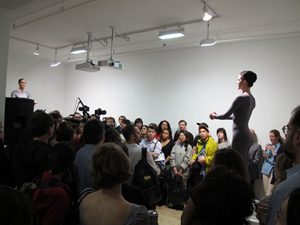A Century of Fears
John Haberin New York City
The 2013 New York Art Fairs
The Association of American Painters and Sculptors managed exactly one exhibition, but a doozy. Work like Nude Descending a Staircase, by Marcel Duchamp, created a scandal. Even Teddy Roosevelt weighed in to ask if this was art.
With thirteen hundred paintings by some three hundred artists, he would have had plenty of reasons for doubt. The International Exhibition of Modern Art, known ever since as the 1913 Armory Show, often gets credit for introducing modern art to America. Yet it also helped to bring American art into the twentieth century. 
Contemporary art may have lost the power to shock, but it sure inspires fear. On the hundredth anniversary of the 1913 Armory Show, the event that galvanized American artists and took Modernism into the headlines, any sane person would be hiding under the bed. Instead, on the second weekend in March, people formed long lines for at least seven competing art fairs.
Of course, I have in mind fear for art. That is a long way from fear of art, but it is hard not to think about what has changed in a century. Already, two suburban museums have honored the past with small "recreations," which in practice means a few of the old names. More than one booth at the 2013 Armory Show paid tribute to Marcel Duchamp (including an actual urinal at Brooklyn's Pierogi gallery), which in practice could mean anything at all. On the Lower East Side, at the Abrons Art Center, "Decenter" hoped to find something of the vitality of the original in some of the brightest and least overexposed names today. Meanwhile the rest of us were doing out best to get over our fears.
Those 1913 dollars
Those fears of art fairs and fears for the state of the art naturally have to do with money. They include the fear of not keeping up—and fear of the cost to dealers who try. Take tens of thousands of dollars apiece for a booth at the Armory Show ($24 thousand, to be precise) or the Art Dealers Association of America's Art Show, at the Park Avenue Armory. Double that for several dealers that appeared in both, and be sure to add in shipping, insurance, and staffing, as documented in photographs by Andy Freeberg. Try to decide, too, whether they were losing business at the gallery or gaining from an event. Do not even bother to translate it all into 1913 dollars.
All that means tough choices for anyone in art trying to survive. It also means tough demands on anyone trying to find meaning in art apart from the money trail. Maybe Modernism really has survived one hundred years, while Postmodernism and its spirit of critique seem already more often than not a thing of the past. Today's Armory Show has a separate Hudson River pier for what it calls the modern, where only those with VIP passes get to use the stairs to avoid crushing lines for the elevators. VIP passes to Fountain, at the site of the original Armory Show, cost $50—and that is for arguably the least prestigious of the weekend's action. All told, where the first Armory Show was about bringing modern art to America, this weekend is about bringing money to New York.
As ever these days, one fears most for midlevel dealers, just as when galleries reopened-19 after Hurricane Sandy or Covid-19. Not every problem can be solved by throwing money at it, but some can. That very Friday Gagosian opened a museum-quality show of Helen Frankenthaler in Chelsea on top of a huge show of Jean-Michel Basquiat three blocks away. The low end may survive, too, because it is malleable, because costs are low, and because discovering emerging artists has an appeal to collectors all its own. Bushwick and Lower East Side galleries mostly sat the fairs out, hoping instead to draw crowds with extended evenings. They can also choose from another round of fairs in May.
That still leaves plenty of artists and dealers alike who put their lives into their work. It also leaves all the fairs trying desperately to find something new to say to compete for attention after the 2012 art fairs, 2011 art fairs, 2010 art fairs, and so on and so on. The Armory Show even hired a focus group (filmed by an artist in "Decenter"), resulting in a few more single-artist installations. The ADAA encouraged single-artist booths, although it does not insist on them as Volta has from the start. Volta and Scope both have new locations, in Soho and in the grand post office behind Penn Station. The Independent dispenses with booths entirely, in the former Dia:Chelsea, while Moving Image is back with, well, moving images—and both are free to visitors.
Each fair, too, raises fears all its own. Sure, one has every reason to set those fears aside. This is a celebration of the state of the art, with a broader public than ever for hundreds and hundreds of good or even great artists. Part of the fun of a lesser art fair is finding things that one had missed. And part of the fun of the pricier fairs is finding how much is still up for sale. Still, the fears are real.
In fact, they boil down to the fears one has for art each and every day. They just loom larger on the anniversary of Modernism's first century. Even influential critics outside of academia have been decrying the art scene as a "battle for Babylon" or too much big installation art. Again the real culprit is money. Almost the first booth on the piers displays a Warhol dollar sign. I crawled out from under the bed, against my better judgment, mostly to face my fears.
From shock to fears
They came at me in a riot of sensation at Scope. New York galleries have increasingly abandoned this fair, under pressure to move up with success, leaving displays from mostly smaller European and American cities. They run to the obvious, with a fair degree of representation, often cropped, enlarged, and mixed with sculptural elements to be absolutely certain to get in your face. I went in no small part for the lure of the central post office. I wondered what will happen if Penn Station with help from Moynihan Train Hall makes a more imposing entrance through the building's front. In reality, partitions and curtains look much the same anywhere, even under a 1912 skylight.
At the other extreme, the ADAA traffics in sobriety. One can take pleasure in the quality from the many New York galleries or from a market so much more open now to women like Sonia Delaunay and Sophie Taueber-Arp. Somehow, a glass puzzle box by Vija Celmins slips so effortlessly into a booth largely dedicated to Joseph Cornell, at L&M Arts, that either scavenger would have taken pleasure. On the other hand, one has to wonder at a fair so dedicated to the dignity of American art that, to single out one of the finest, Barbara Gladstone manages to turn Robert Bechtle into an heir to Edward Hopper and Hopper drawings. One has to wonder, too, how so many people could want so much Milton Avery. And then try to face how Modernism for its pier at the Armory Show can mean mostly Andy Warhol, Frank Stella, and an endless array of lesser 1960s abstraction and Pop Art.
 Nothing else promises so much or is half as dispiriting. Yet the crush of the Armory Show's contemporary pier is dispiriting in its own way—in business as usual. No wonder here Gladstone turns to Alighiero Boetti. By now, one should see a pattern, for each of these shows is, in its own way, savvy about its audience. It may mean glitter, Americana, dignity, modern art's history, or just another weekend in Chelsea displaced a mile or so north, but it still means supply and demand. The fairs need not preclude explosive art to bring back one's deepest fears.
Nothing else promises so much or is half as dispiriting. Yet the crush of the Armory Show's contemporary pier is dispiriting in its own way—in business as usual. No wonder here Gladstone turns to Alighiero Boetti. By now, one should see a pattern, for each of these shows is, in its own way, savvy about its audience. It may mean glitter, Americana, dignity, modern art's history, or just another weekend in Chelsea displaced a mile or so north, but it still means supply and demand. The fairs need not preclude explosive art to bring back one's deepest fears.
The Independent has an enticing mix of strangers, mostly from Europe and the lower west side of Manhattan. Still, one cost of its open layout is to make it hard at times to tell them apart. The fair as a whole may be the most innovative work of installation art to date. I look forward most to Moving Image, in its glorious brick warehouse "tunnel" in Chelsea—and I was not disappointed, but it, too, has its limits. It includes funky animal videos (like birds from Greta Alfaro, white bats from Jan Tichy, an explorer of gallery light and structure, and an actual tank of sea monkeys from Ted Victoria), the simulated landfills of Jennifer and Kevin McCoy, and Cheryl Pope's existential party night in collision with water balloons. Yet the experiment of new media has taken a back seat to personal narratives of crowds, confessions, and (from Tellervo Kalleinen and Oliver Kochta-Kalleinen) "The Complaint Choir of Tokyo."
For all that, bear in mind what not to fear. The fairs, like all of art, are about far more than celebrity artists and inflated auction prices, for all the Damien Hirst splatter paintings on pier 92. They are not, pace Robert Hughes, about the death of art since Andy Warhol, although that pier could easily have called itself "Regarding Warhol." They are not about conceptual art and installations chasing out the handmade, for they depend on the art object, as something to sell. They are not about failing to integrate outsider art into the life of contemporary art, not when Martín Ramirez hangs beside William Edmondson's elegant primitivism in sculpture from 1934 or Tom Duncan at Andrew Edlin goes to town. Besides, full integration would reduce all of art to its subject matter.
Ultimately, the real fears are for the future. Contemporary art is heading everywhere and nowhere, with more trends and more talent at the expense of the passion and the shocks. The Armory Show can even afford to display a 2007 text painting by Mel Bochner, about Vulgar Tastes and the Nouveau Riche, and I bet it sold. Maybe one must simply wait until May and July, for the Frieze, Pulse, and NADA fairs, to see art beyond Chelsea. Or one can wait for the day after the fairs, when the old categories for old media break down once more, and the usual chaos begins anew. After all, one has already waited a century.
Decenter cannot hold?
What would Cubism look like now, exactly a century later, and can the Lower East Side share in its legacy? These days the Lexington Avenue armory hosts just one of at least a dozen New York art fairs, while the Abrons Art Center stands between housing projects and a scene. The public is unlikely even to notice a show there, much less take outrage, not even with David Kennedy Cutler's tall, silvery cocoon out front shimmering in the night. Shocks in art have long since given way to commercialism and fatigue, except perhaps for politicians eager to exploit them. Movements have given way to pluralism, DIY, and confusion. Modernism has fallen apart, and the center cannot hold.
"Decenter" at Abrons may not look radical, then, but it holds its center. Andrianna Campbell and Daniel S. Palmer stick to twenty-seven artists and a genuine sensibility. They know the Lower East Side scene, like Douglas Melini's busy diamond patterns and N. Dash's folds of deep black, in graphite on paper. They accept someone as established as Gabriel Orozco, with ink and acrylic shadows of flowers, like a distant echo of Man Ray, László Moholy-Nagy, and photograms. Mostly, though, they belong to art's midlevel adventure that collectors so often overlook. And they derive their formal terms less from Cubism than the computer. 
"Decenter" has a portion only on the Web, with its menu in the form of a network. The interface could parody careerism—or Alfred Barr's famous diagram for MoMA of Cubism and abstract art. It is also the site's highpoint, on the way to quasi-random animations and a slide show about online paranoia, by Tony Cokes. Cory Arcangel first gained attention with art as a video game, I Shot Andy Warhol. This time he appropriates enough copyright material that his piece, I was informed, is unavailable in my country, wherever that is. Still, the pairing of virtual and real exhibitions is much too rare even now, when artist Web sites are all too necessary.
Most of the show takes physical shape anyway, which makes its ties to computer imagery all the more provocative. It also puts a high-tech gloss on a broader trend, the merger of abstract art with realism or photography—a merger that, appropriately enough, goes back to Georgia O'Keeffe and O'Keeffe drawings, Alfred Stieglitz, and the real beginnings of modern art in America. While Despina Stokou in Chelsea recently had QR bar codes next to her paintings, Douglas Coupland here updates geometric abstraction to the point that I wanted to scan it. Jessica Eaton's photos, Amy Feldman's loose shapes on white, Michael Delucia's irregular pyramid, and Andrew Kuo's chart of his existence push the limits of an algorithm as well. Tall acrylics by Ethan Greenbaum have stains as eerie as laboratory slides, and photos by Sara VanDerBeek take a dancer's legs less out of the Freudian unconscious than another world. Ulrike Mohr's overhead spiral sculpture outgrows any laboratory device, but only barely.
Only a few artists refer directly to early Modernism. Franklin Evans papers the stairs with its history, while Andrea Geyer's text paintings cite older artists and patrons. Large Polaroids by Barbara Kasten or Seher Shah's architectural renderings could come right out of the Bauhaus. Gregor Hildebrandt's cassette tape on canvas recalls Arnold Schönberg's Pierrot Lunaire thrice over—in its medium, its subject, and its blackness. Travess Smalley's photographs of compositions in clay evoke peeling walls, as if to preserve the past in the midst of physical decay. And Liz Magic Laser (who also created a film for the 2013 Armory Show) pairs male and female mimes on facing screens, adding gender bending to a history of modern dance.
Armory Show (and Liz Magic Laser) or not, America came screaming and kicking into the new century. Of the founders of the Association of American Painters and Sculptors, Arthur B. Davies was just beginning to allow hints of Cubism and abstraction into his languid Elysian fields. Walt Kuhn's detour to Europe recruited its art for the occasion, but as a painter he never outgrew his circus clowns. George Bellows, too, had a part in hanging the show, while never quite knowing what art's "new spirit" meant for American realism. Fifty years later, in founding the Abrons Art Center, the Henry Street Settlement tried to restage the Armory Show—not bad timing, when the Lower East Side was still on the fringe and art could still shock. Now, on the show's hundredth anniversary, "Decenter" can hold, but then Modernism still lingers just off-center.

The 2013 New York art fairs ran March 8–10, "Decenter" at the Abrons Art Center through April 7, and Despina Stokou at Derek Eller through March 16. Another related review reports on a panel discussion of "Art Fairs: An Irresistible Force?" After reporting for six years in a row now, including Frieze and NADA, plus more than once before that and with the 2014 art fairs, 2015 art fairs, 2016 art fairs, 2017 art fairs, 2018 art fairs, 2019 art fairs, 2020 art fairs, spring 2022 art fairs, fall 2022 art fairs, spring 2023 art fairs, and fall 2023 art fairs to come, including Frieze, Frieze online, Art New York, and NADA.




